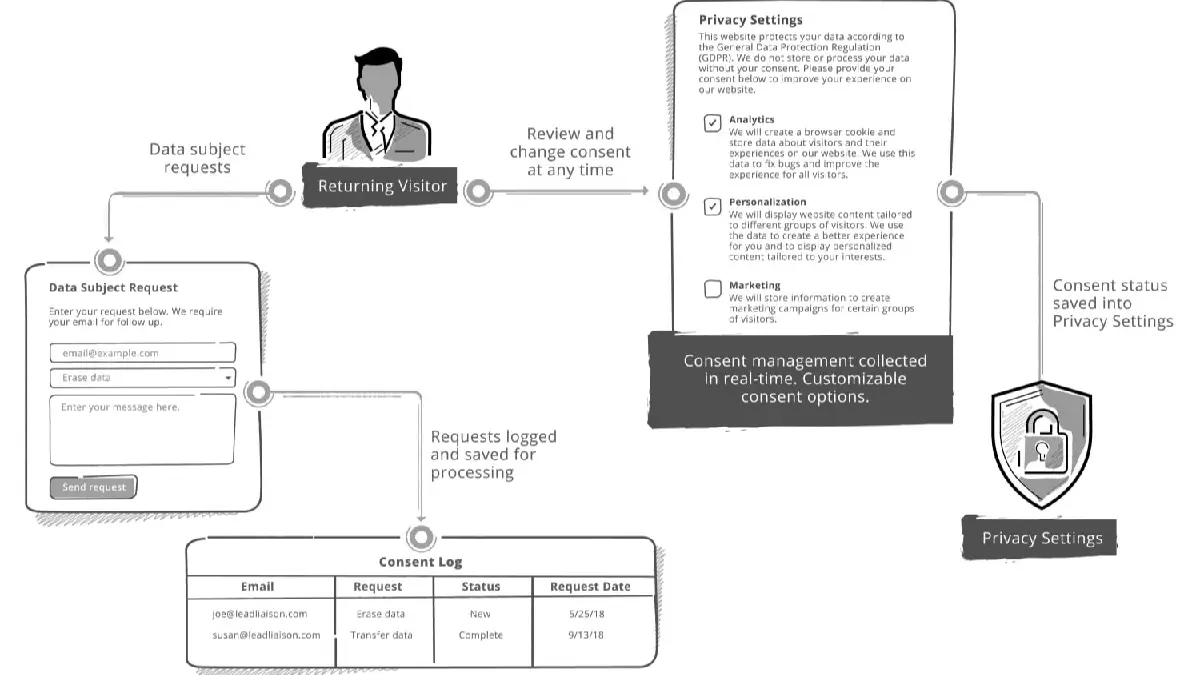Consents are an essential component of any data privacy project, and their management is most efficiently accomplished with the help of automated systems. The processing of personal data must be based on valid consent to comply with several requirements. However, before getting into the technological components of putting in place a consent management system, it is vital to have a solid understanding of the concept of consent itself. By doing so, we will be able to create a connection between the requirements for regulatory permission and the technology implementation demands of organizations. In this blog, we will explore API-driven Approaches to Simplify Consent Management.
“Consent is an affirmative and voluntary action taken by a data subject, indicating their willingness to allow an organization to process their personal data. It entails the data subject's explicit approval, granting the organization permission to carry out specific data processing activities as described in the organization's privacy notice.“
Organizations should put in place a system that makes it easy for data subjects to grant or withdraw consent by using an existing or specially designed form. Manually recording and processing consents is possible, but it quickly becomes unmanageable and disorganized as a company deals with a large number of consents. Tracking and managing consents manually is difficult and fraught with the possibility of human error. As a result, a specialized consent management platform is strongly suggested.
Consent kinds must be taken into account when designing a consent management system. Preference consents and cookie consents are two prominent examples. Manually managing preference consents is feasible when the volume is low, but becomes extremely challenging when the volume increases. Consents gained during registration, service enrollment, or subscribing to marketing mailings are all examples of the kind of consents included in the broader category of “preference consents,” which also includes cookies. We’ll be talking a lot about how to organize and handle preference consents in this blog.
In the realm of consent management, organizations heavily rely on CRM systems and databases to store and utilize customer data. These systems are instrumental in automating various communication channels such as marketing emails, product updates, promotions, and offers. However, with the advent of data privacy regulations, organizations must now ensure that recipients of these emails have explicitly consented to receiving such communications. Hence, the collection, modification, and revocation of consent have become crucial considerations.
Furthermore, consent collection points can arise at multiple touchpoints with data subjects, and these touchpoints often integrate not only with CRM systems but also with various other internal systems within the organization. Consequently, implementing an effective consent management system is far more complex than it may initially seem. The key challenge lies in ensuring that when a data subject updates their consent, the changes are reflected consistently across all associated systems, rather than solely within the initial consent collection database.
To address this challenge, one solution is to leverage APIs for seamless integration between the Data Privacy Automation tool (consent tool) and CRM systems, as well as other relevant databases. By employing APIs, consent records can be efficiently pushed and pulled between these systems, enabling the management and updating of data subject consents according to a desired schedule. This approach ensures that consent records remain consistent and synchronized across all databases, facilitating effective consent management.
Below is a visual representation illustrating how a consent management tool can be integrated with a CRM system. Consents can be seamlessly imported from or exported to the CRM system, ensuring that business processes align with user preferences and promoting streamlined consent management.

Source: https://www.leadliaison.com/gdpr-consent-management/
By utilizing APIs to bridge the gap between consent management tools and CRM systems, organizations can achieve a harmonized and efficient approach to consent management, enhancing compliance and improving the overall data privacy landscape.
Let’s explore a couple of examples to understand how APIs contribute to maintaining a unified consent management system. In one scenario, a company allows users to specify their marketing email preferences on their website. The consent management tool collects the user consents, which are then updated in the CRM platform responsible for sending marketing emails. This ensures that users only receive desired communications, eliminating unsolicited emails. Another instance involves the inclusion of an “Unsubscribe” link in emails sent via the CRM platform. To maintain a single source of truth, consents from the CRM must be synchronized with the consent management tool. APIs offered by both the consent management and CRM tools facilitate this synchronization process.
By adopting this API-driven approach, organizations can benefit from the following advantages:
- Single Source of Truth: APIs enable the maintenance of a unified consent repository, eliminating discrepancies across systems and ensuring consistency in consent data.
- Real-Time User Preference Updates: With APIs, user preferences can be updated in real-time, ensuring immediate synchronization between the consent management tool and relevant systems.
- Efficient Consent Operations: APIs streamline consent management processes throughout the organization, enabling efficient handling of consent across different departments and systems.
- Integration with Multiple CRMs and Data Systems: APIs empower organizations to integrate their consent management tool with various CRMs and data systems, facilitating seamless consent synchronization and management.
- Improved Scalability: API-driven consent management solutions can easily scale to accommodate growing data volumes and evolving business needs.
While APIs offer significant benefits, it’s essential to consider certain factors and potential drawbacks:
- Compatibility and Skill Requirements: Organizations should assess the compatibility of APIs with existing systems and evaluate the necessary skill sets required for implementing and maintaining a consent management system.
- Maintenance and Security Considerations: API-based solutions require regular maintenance and robust security measures to protect the integrity and privacy of consent data.
While APIs provide a powerful means to achieve synchronized and real-time consent management, organizations should carefully evaluate the advantages and disadvantages in the context of their specific data privacy landscape. By conducting a comprehensive analysis, organizations can make informed decisions to establish an effective and compliant consent management framework.
About Concur – Harmonizing Data Compliance
Concur is a technology company that provides a suite of enterprise solutions to help organizations manage their data compliance and other business operations. Our solutions include consent management, digital policy management, legacy customer notice guidelines, data principal rights solutions, and more. With a focus on innovation and the use of blockchain technology, Concur helps enterprises to stay compliant with various regulations such as DPDPB, while streamlining their operations and enhancing overall efficiency. Additionally, they offer dedicated support through their Support Center to ensure customers have the assistance they need to achieve their compliance goals.

